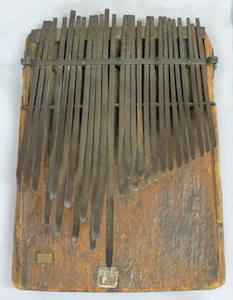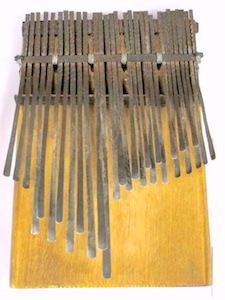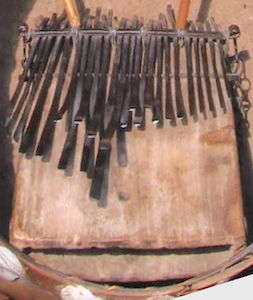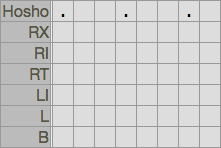Scale degrees are numbered from
1 to
7;
4 being the lowest key of the instrument.
It is the same as the
Pitch+Octaves.4 notation,
with all octave indication omitted where it can be deduced from the playing area.
Only the
5, and
5 keys in the
L manual need to be distinguished.
Some instruments and transcriptions employ right index finger keys up to
RI4 and
RI5.
Comparing this notation with
Pitch of the mbira dzavadzimu reveals similarities in the key layout,
e.g. the characteristic sequence
L1 L5 L4 L6 L7 L1' on the mbira matching the
L1 L5 L4 LI6 LI7 LI1 keys on the Hera.
Key Overview
The table below shows all keys of the notation, from lowest to highest.
Each row contains all possible keys for that playing area.
Each column contains all keys of the same pitch.
Not all instruments may have keys matching all these notes.
Red notes are
alias names
for the same key, if it can be played with different fingers.
| Hosho | . | | | | | | | | | | | | | | | | | | | | | | | | | | |
| RX | | | | | | | | | | | | | | | | | | | | | 2 | 3 | 4 | 5 | 6 | 7 | 1 |
| RI | | | | | | | | | | | | | | | | 4' | 5' | 6 | 7 | 1 | 2 | 3 | 4 | 5 | | | |
| RT | | | | | | | | | 4/ | 5/ | 6 | 7 | 1 | 2 | 3 | 4 | 5 | | | | | | | | | | |
| LI | | | | | | | | | | | 6 | 7 | 1 | 2 | 3 | | | | | | | | | | | | |
| L | | | 5, | | | 1 | | | 4 | 5 | 6 | | | | | | | | | | | | | | | | |
| B | | 4 | | 6 | 7 | | 2 | 3 | | | | | | | | | | | | | | | | | | | |
Aliases
The table below lists all alias keys.
Row names are shown in black, cell content in red.
| Key | Alias | Notes |
|---|
| RT4 | RI4' | RT4 key played with the index finger instead of the thumb |
| RT5 | RI5' | RT5 key played with the index finger instead of the thumb |
Same numbers as the
Pitch.4 notation, but full octave indication.
Some instruments and transcriptions employ right index finger keys up to
RI4'' and
RI5''.
Key Overview
The table below shows all keys of the notation, from lowest to highest.
Each row contains all possible keys for that playing area.
Each column contains all keys of the same pitch.
Not all instruments may have keys matching all these notes.
Red notes are
alias names
for the same key, if it can be played with different fingers.
| Hosho | . | | | | | | | | | | | | | | | | | | | | | | | | | | |
| RX | | | | | | | | | | | | | | | | | | | | | 2'' | 3'' | 4'' | 5'' | 6'' | 7'' | 1''' |
| RI | | | | | | | | | | | | | | | | 4' | 5' | 6' | 7' | 1'' | 2'' | 3'' | 4'' | 5'' | | | |
| RT | | | | | | | | | 4 | 5 | 6 | 7 | 1' | 2' | 3' | 4' | 5' | | | | | | | | | | |
| LI | | | | | | | | | | | 6 | 7 | 1' | 2' | 3' | | | | | | | | | | | | |
| L | | | 5, | | | 1 | | | 4 | 5 | 6 | | | | | | | | | | | | | | | | |
| B | | 4, | | 6, | 7, | | 2 | 3 | | | | | | | | | | | | | | | | | | | |
Aliases
The table below lists all alias keys.
Row names are shown in black, cell content in red.
| Key | Alias | Notes |
|---|
| RT4' | RI4' | RT4' key played with the index finger instead of the thumb |
| RT5' | RI5' | RT5' key played with the index finger instead of the thumb |
This is the same as the
Pitch.4 notation, with 1 as the lowest key on the instrument.
Some instruments and transcriptions employ right index finger keys up to
RI1 and
RI2.
Key Overview
The table below shows all keys of the notation, from lowest to highest.
Each row contains all possible keys for that playing area.
Each column contains all keys of the same pitch.
Not all instruments may have keys matching all these notes.
Red notes are
alias names
for the same key, if it can be played with different fingers.
| Hosho | . | | | | | | | | | | | | | | | | | | | | | | | | | | |
| RX | | | | | | | | | | | | | | | | | | | | | 6 | 7 | 1 | 2 | 3 | 4 | 5 |
| RI | | | | | | | | | | | | | | | | 1' | 2' | 3 | 4 | 5 | 6 | 7 | 1 | 2 | | | |
| RT | | | | | | | | | 1/ | 2/ | 3 | 4 | 5 | 6 | 7 | 1 | 2 | | | | | | | | | | |
| LI | | | | | | | | | | | 3 | 4 | 5 | 6 | 7 | | | | | | | | | | | | |
| L | | | 2, | | | 5 | | | 1 | 2 | 3 | | | | | | | | | | | | | | | | |
| B | | 1 | | 3 | 4 | | 6 | 7 | | | | | | | | | | | | | | | | | | | |
Aliases
The table below lists all alias keys.
Row names are shown in black, cell content in red.
| Key | Alias | Notes |
|---|
| RT1 | RI1' | RT1 key played with the index finger instead of the thumb |
| RT2 | RI1' | RT2 key played with the index finger instead of the thumb |
This notation is based on James Kamwaza's numbering scheme as described in
Jocelyn Mory's Yelloweaver blog.
The seven scale degrees are numbered top-down,
1 being the highest pitch of
a Hera's left thumb area, which James considers as the core of each piece.
Following the sequence,
L0 was added to the notation for a key not present on Kamwaza's Hera.
Some instruments and transcriptions employ right index finger keys up to
RI2 and
RI1.
Key Overview
The table below shows all keys of the notation, from lowest to highest.
Each row contains all possible keys for that playing area.
Each column contains all keys of the same pitch.
Not all instruments may have keys matching all these notes.
Red notes are
alias names
for the same key, if it can be played with different fingers.
| Hosho | . | | | | | | | | | | | | | | | | | | | | | | | | | | |
| RX | | | | | | | | | | | | | | | | | | | | | 4 | 3 | 2 | 1 | 7 | 6 | 5 |
| RI | | | | | | | | | | | | | | | | RT2 | RT1 | 7 | 6 | 5 | 4 | 3 | 2 | 1 | | | |
| RT | | | | | | | | | 9 | 8 | 7 | 6 | 5 | 4 | 3 | 2 | 1 | | | | | | | | | | |
| LI | | | | | | | | | | | 7 | 6 | 5 | 4 | 3 | | | | | | | | | | | | |
| LT | | 9 | 8 | 7 | 6 | 5 | 4 | 3 | 2 | 1 | 0 | | | | | | | | | | | | | | | | |
Aliases
The table below lists all alias keys.
Row names are shown in black, cell content in red.
| Key | Alias | Notes |
|---|
| RT2 | RIRT2 | RT2 key played with the index finger instead of the thumb |
| RT1 | RIRT1 | RT1 key played with the index finger instead of the thumb |
This positional notation is based on a handwritten transcription by Chaka Chawasarira. Even though most keys have their
individual number, the playing areas of the both hands (
L,
L,
B and
RT,
RI,
RX) are distinguished, to avoid two numbers
in the same table cell, e.g.
11/20 if right thumb and index play together.
I've also added the
RX keys to Mr. Chawasarira's original numbering to achieve a complete mapping
between the different notations.
Some instruments and transcriptions employ right index finger keys up to
RI23 and
RI24.
Key Overview
The table below shows all keys of the notation, from lowest to highest.
Each row contains all possible keys for that playing area.
Each column contains all keys of the same pitch.
Not all instruments may have keys matching all these notes.
Red notes are
alias names
for the same key, if it can be played with different fingers.
| Hosho | . | | | | | | | | | | | | | | | | | | | | | | | | | | |
| RX | | | | | | | | | | | | | | | | | | | | | 1 | 2 | 3 | 4 | 5 | 6 | 7 |
| RI | | | | | | | | | | | | | | | | 16 | 17 | 18 | 19 | 20 | 21 | 22 | 23 | 24 | | | |
| RT | | | | | | | | | 11B | 11A | 12 | 14 | 11 | 13 | 15 | 16 | 17 | | | | | | | | | | |
| LI | | | | | | | | | | | 25 | 24 | 23 | 23A | 23B | | | | | | | | | | | | |
| L | | | 9 | | | 7 | | | 3 | 5 | 1 | | | | | | | | | | | | | | | | |
| B | | 10 | | 8 | 6 | | 4 | 2 | | | | | | | | | | | | | | | | | | | |
Aliases
The table below lists all alias keys.
Row names are shown in black, cell content in red.
| Key | Alias | Notes |
|---|
| RT16 | RI16 | RT16 key played with the index finger instead of the thumb |
| RT17 | RI17 | RT17 key played with the index finger instead of the thumb |
This notation is based on the one used by Joel Laviolette in his
Rattletree forum. The keys in each playing area are numbered bottom-up according to their pitch.
Joel only uses
R for the right hand), but this notation also distinguishes the playing areas of the right hand
(
RT,
RI and
RX),
to avoid two numbers (e.g.
3/10) in the same table cell if right thumb and index play together.
Some instruments and transcriptions employ right index finger keys up to
RI13 and
RI14.
Key Overview
The table below shows all keys of the notation, from lowest to highest.
Each row contains all possible keys for that playing area.
Each column contains all keys of the same pitch.
Not all instruments may have keys matching all these notes.
Red notes are
alias names
for the same key, if it can be played with different fingers.
| Hosho | . | | | | | | | | | | | | | | | | | | | | | | | | | | |
| RX | | | | | | | | | | | | | | | | | | | | | 1 | 2 | 3 | 4 | 5 | 6 | 7 |
| RI | | | | | | | | | | | | | | | | 6 | 7 | 8 | 9 | 10 | 11 | 12 | 13 | 14 | | | |
| RT | | | | | | | | | 1B | 1A | 1 | 2 | 3 | 4 | 5 | 6 | 7 | | | | | | | | | | |
| L | | | | | | | | | | | 1 | 2 | 3 | 4 | 5 | | | | | | | | | | | | |
| B | | 1 | 2 | 3 | 4 | 5 | 6 | 7 | 8 | 9 | 9A | | | | | | | | | | | | | | | | |
Aliases
The table below lists all alias keys.
Row names are shown in black, cell content in red.
| Key | Alias | Notes |
|---|
| RT6 | RI6 | RT6 key played with the index finger instead of the thumb |
| RT7 | RI7 | RT7 key played with the index finger instead of the thumb |



